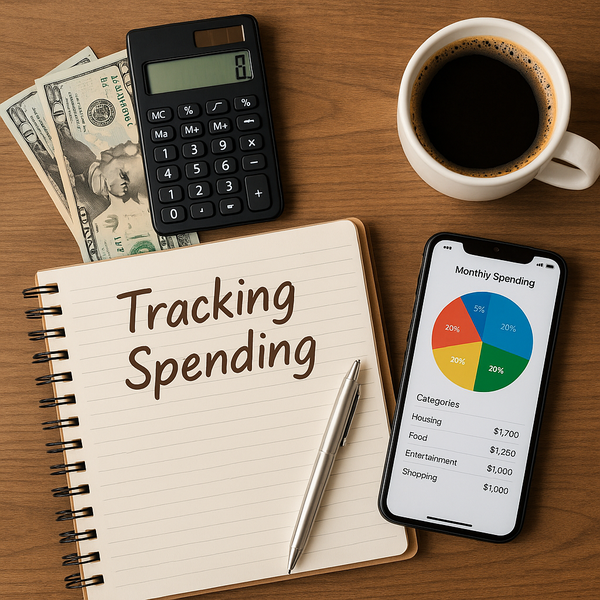
Understanding where your money goes is the foundational step toward achieving financial well-being. Without a clear picture of your income and expenses, it's nearly impossible to create a realistic budget, save for future goals, or reduce debt effectively. Tracking spending habits is not just about knowing your balance; it's about gaining control and making informed decisions about your financial future.
Why Tracking Your Spending Matters
Many people are surprised to discover where their money truly goes once they start tracking. Small, seemingly insignificant purchases add up quickly. Tracking reveals these patterns, highlighting areas where you might be overspending or where you can find opportunities to save. It turns abstract financial goals into concrete actions by providing the necessary data to build and stick to a budget. It's the difference between *thinking* you know your habits and *knowing* your habits based on real data.
Popular Methods for Tracking Spending
There isn't one single 'right' way to track spending; the best method is the one you will actually use consistently. Manual methods like using a simple notebook or a spreadsheet (like Excel or Google Sheets) offer flexibility and a hands-on approach. You physically write down or type in each expense, which can help reinforce the habit. Spreadsheets allow for easy categorization and basic analysis.
Digital methods are increasingly popular due to their convenience and automation. Budgeting apps (many are free) link directly to your bank accounts and credit cards, automatically categorizing transactions. This reduces the manual effort significantly. Some banking apps also offer built-in spending analysis tools. While automated tracking is convenient, it's still important to review and adjust categories periodically to ensure accuracy.
Getting Started: Simple Steps
First, choose a method that feels manageable for you. Don't try to use a complex app if you're not tech-savvy, and don't rely on a notebook if you're likely to forget to write things down. Commit to tracking every single expense, no matter how small. A coffee here, a magazine there – they all count. Decide on your spending categories. Common ones include housing, transportation, food (groceries and dining out), utilities, insurance, debt payments, entertainment, personal care, and miscellaneous. Having clear categories makes analysis easier.
Consistency is key. Try to log expenses daily or every few days. Set reminders if necessary. The goal is to capture everything so you have a complete picture at the end of your tracking period (usually a month). Don't worry about judging your spending at this stage; focus purely on collecting the data accurately.
Analyzing Your Spending Data
Once you've tracked for a full month, it's time to analyze. Look at the total spent in each category. How does this compare to what you thought you were spending? Identify your largest spending areas. Are there categories where your spending seems unusually high or where you consistently go over what feels reasonable? This analysis stage is where the insights begin to emerge. Look for patterns – are you spending more on dining out on certain days? Are impulse purchases a significant drain? Use the data to understand your habits without judgment initially.
Turning Data into Action
Tracking isn't just an academic exercise; it's the foundation for action. The insights gained from tracking directly inform your budget. Based on your actual spending data, you can create a realistic spending plan for the next month. If you found you spent too much on entertainment, you can consciously allocate less to that category for the following month. Conversely, if you spent less on groceries than expected, you might reallocate those funds towards savings or debt repayment.
Tracking empowers you to make conscious decisions about your money instead of wondering where it went. It helps you prioritize spending based on your values and goals. Want to save for a down payment? Seeing exactly where your money is going allows you to identify funds that can be redirected to savings.
Common Challenges and How to Overcome Them
Getting started is often the hardest part. Forgetting to track transactions is common, especially at first. Try linking it to another habit, like logging expenses every evening before bed. Feeling overwhelmed by the data can also be a challenge. Start simple; focus on just a few major categories initially if needed. Irregular expenses, like annual insurance payments or holiday gifts, can skew monthly data. Account for these by setting aside a little each month for them.
Another challenge is feeling guilty about past spending. Remember, tracking is about gaining awareness for future improvement, not dwelling on the past. Focus on the progress you're making. Automating aspects of tracking through apps can reduce the burden and make it easier to stick with long-term.
Making Tracking a Habit
Consistency over time is what transforms tracking from a chore into a powerful financial tool. Aim to review your spending at least weekly. This helps you stay accountable and catch discrepancies early. At the end of each month, perform a more thorough review. How did you do compared to your goals? What went well, and what could be improved? Use these insights to adjust your budget for the next month. Celebrate hitting your spending targets or finding ways to save. Making tracking a regular, integrated part of your financial routine will yield significant benefits over time.
Tracking your spending is the crucial first step towards taking control of your financial life. It provides the clarity needed to make informed decisions, build effective budgets, and work towards your financial goals. By committing to tracking, you empower yourself to manage your money proactively and pave the way for a more secure and prosperous future.

